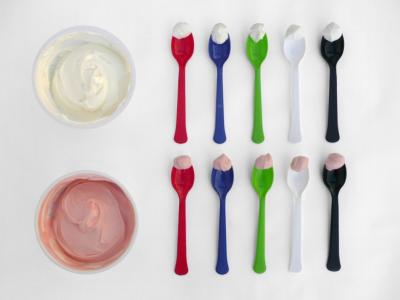Your Choice of Spoon Changes the Taste of Your Food
White yogurt eaten from a white spoon was deemed sweeter, more expensive and denser than a similar yogurt that was dyed pink.
The next time you’re getting ready to eat, think carefully about what utensil you choose to dig into that tasty morsel. Researchers, publishing in the journal Flavour, showed that how we perceive food and even how we taste it, can be affected by the type of cutlery we use.
One of the food stuffs that researchers from the University of Oxford took as a subject was yogurt. And they came up with some bizarre results. For example: yogurt was perceived to be denser and more expensive when eaten from a light plastic spoon, as opposed to a weighted plastic spoon.
They also tested the effect of color on yogurt-eaters. White yogurt eaten from a white spoon was deemed sweeter, more expensive and denser than a similar yogurt that was dyed pink. When the subjects ate the pink and white yogurt with black spoons, the effects were reversed.
The researchers didn’t just limit themselves to a single dairy product though. They also tested whether the shape of cutlery would affect the taste of cheese and found that cheese tasted saltier when eaten off a knife as opposed to a spoon, fork or toothpick.
From the study:
Food ratings were compared after participants sampled two kinds of cheese (a young cheddar and a mature/aged cheddar) from four types of cutlery (a fork, a spoon, a knife, or a toothpick – thereby varying both the visual and the oral-somatosensory attributes of the cutlery). Would the cheese be perceived as ‘sharper’ when tasted from a sharp tool? In an as yet unpublished study, Gal et al. describe how cheddar cheese was reported as sharper when sampled after viewing pointy figures as compared to those who sampled the cheese after viewing rounded images. Gal et al. also reported that the influence of geometric figures on the perception of cheese was mediated by participants’ overall liking for cheese (and thus their prior experience with cheese).
The researchers hope that by figuring out how presentation of food on flatware and cutlery affects people’s appetites, they might be able to apply it to help people have better portion control, or add less salt to food.
Past research has shown that crockery can alter our perception of food and drink.
For example, people generally eat less when food is served on smaller plates.
The new research into how the brain influences food perceptions could help dieters or improve gastronomic experiences at restaurants, said Prof Spence.
He told BBC News: “There’s a lot more to food than what’s on the plate. Many things we thought didn’t matter do. We’re going to see a lot more of neuroscience design around mealtimes.”
More from Smithsonian.com:
USDA Demolishing the Food Pyramid
Ban the Bag: Should Kids Be Forbidden From Bringing Lunch to School?
An Online Food Education
